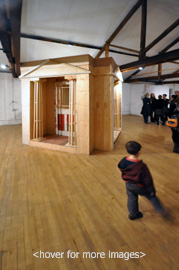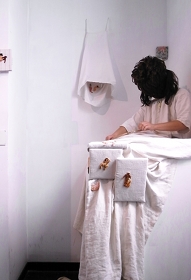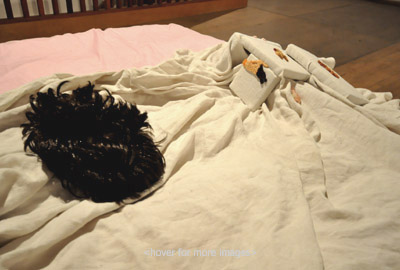|
Ask a child to draw a house and chances are s/he will draw a more or less symmetrical structure with pitched roof, 2 or 4 square-ish windows, a single door somewhat centrally placed, and perhaps a chimney, regardless if the child may actually live in a modernist flat, a Georgian terrace or a suburban sprawl. Yet the same child may also create castles and forts out of spreading tree branches, bits of packaging, or leftover crawl space at the back of a cupboard. One could say in the first instance the child is communicating house via a convention, a “sign”, whereas in the second, s/he is creating a house with the materials and ideas at hand. What does this say about how we are thinking when we are inventing (spaces)?
Our exhibition “Dislocation” explores the making of spaces. It is also about using architecture as a metaphor for thinking – an argument over structuralism and post-structuralism using invented spaces.
Allan Collins’ works read as op art, but they are not interested in creating an illusion, rather in revealing the “source code”, the rules and formulas of their creations. They bedazzle and befuddle with their jewel colours, but their systems are absolutely rigorous.

In contrast, Etsuko Kobayashi’s piece is built spontaneously as both an installation and a performance, with the latter informing and building the former. The installation is a bedroom, with white sheets and soft lights. Then we notice the artist, bedecked with a disfiguring wig. She inhabits the space, sleeping, making embroideries which, like a weaver bird, she adds and takes away from the space.
Alan Bond’s work is apparently straightforward architecture - an almost life-sized replica of the classical guards’ house in front of (London’s) Regent’s Park. Yet with its use of found materials, doors that both invite and block access, it is more a question of the systems of architecture.

The concept of logical – or illogical – form is also explored by Stephen Setford, who constructs, deconstructs and reconstructs furniture. Is the chair for the invigilator just a chair when it is sat upon, a sculpture when it is unoccupied?

Discussion of chair/not-chair may bring to mind a John Berger essay where he described a modernist chair (the Reitveld chair) as “an act of faith”, because whilst the chair’s form was recognizable, its construction and materials were not. He uses the chair to raise the issue of hidden conventions and ideologies in our way of thinking about something as common as a chair. So it is that we also question our architecture, our furniture, our invented spaces: how do we “think” our “houses”?

